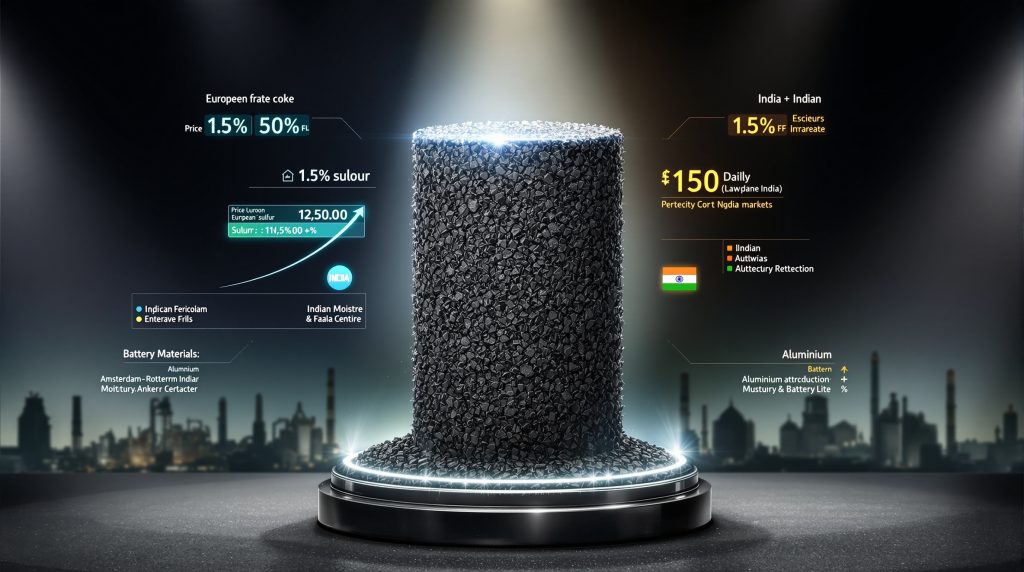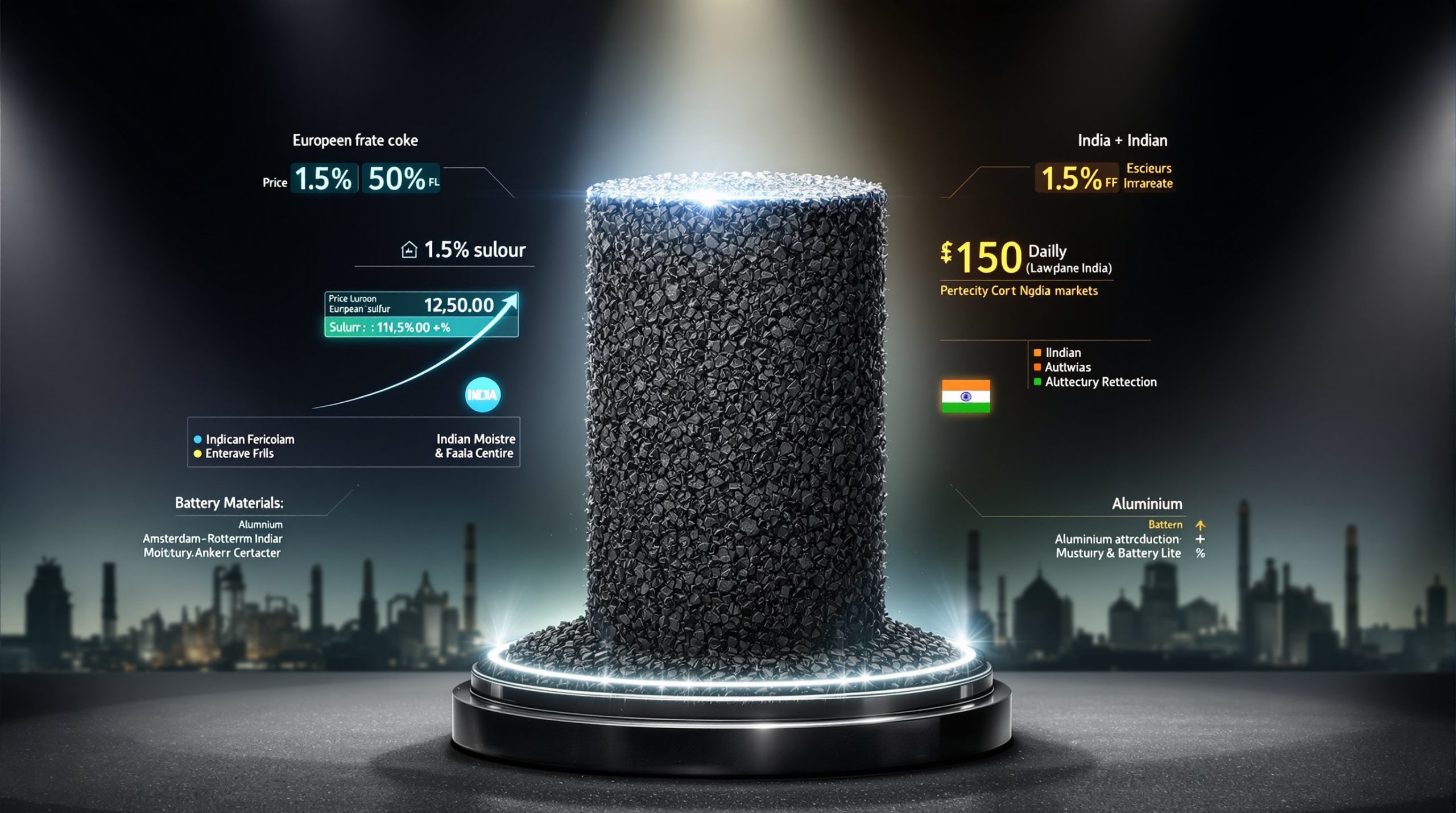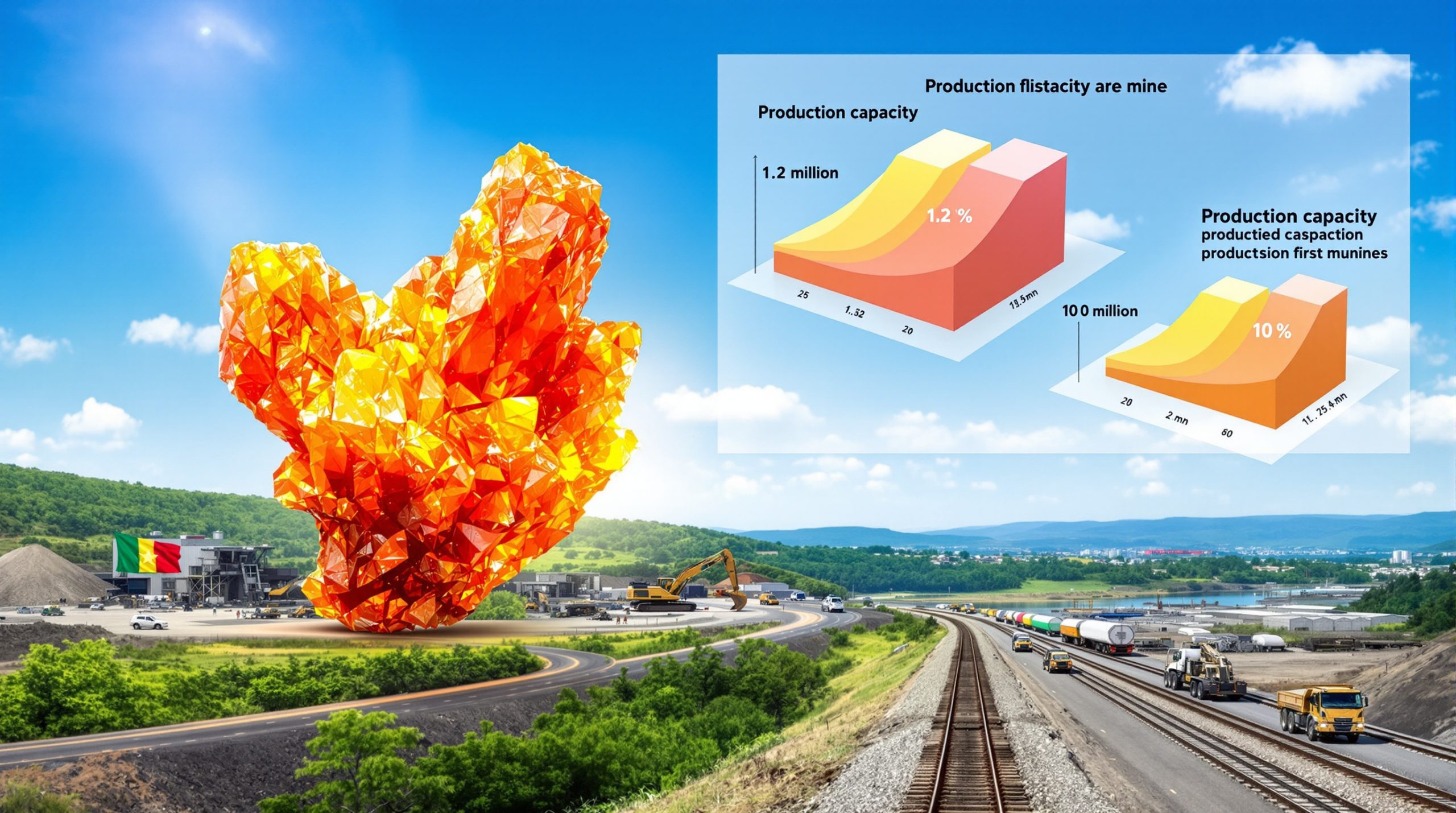Understanding the New Low-Sulfur Green Petroleum Coke Price Assessments in Europe and India
In a significant market development, Fastmarkets recently launched two new price assessments for low-sulfur green petroleum coke in Europe and India. These assessments, introduced on September 25, 2025, aim to provide greater pricing transparency for specialized carbon materials used in high-growth industrial applications, particularly in battery and electrode manufacturing sectors.
What Is Green Petroleum Coke and Why Does Sulfur Content Matter?
The Fundamentals of Green Petroleum Coke
Green petroleum coke represents a carbon-rich solid material produced during petroleum refining. Unlike calcined petroleum coke, green coke remains in its unprocessed state, with the term "green" referring to its raw condition rather than any environmental attributes. This material serves as a crucial feedstock for various industrial processes, from aluminum production to battery materials manufacturing.
Green petroleum coke forms during the final stage of oil refining, specifically in coking units where heavy hydrocarbon residues undergo thermal cracking. The resulting solid carbon material contains varying levels of volatile compounds and impurities depending on the crude oil source and refining process parameters.
The Critical Role of Sulfur Content
Sulfur content stands as perhaps the most crucial quality parameter for petroleum coke applications. The newly launched price assessments specifically target low-sulfur material (1.5% maximum), which commands significant price premiums in global markets for several reasons:
- Lower emissions during industrial processing
- Suitability for higher-value applications including battery materials
- Compliance with increasingly stringent environmental regulations
- Reduced processing costs for end-users
Industrial consumers typically categorize petroleum coke by sulfur content, with low-sulfur grades (under 2%) commanding premium pricing. Higher sulfur variants (3-8%) generally serve as fuel-grade material for cement kilns, power generation, and other combustion applications where emissions can be managed through pollution control systems.
Key Quality Specifications for Industrial Applications
The Fastmarkets assessments focus on material with precise specifications tailored to high-value industrial uses:
- Sulfur: 1.5% maximum
- Nitrogen: 2% maximum
- Moisture: 8% maximum
- Ash: 0.6% maximum
- Volatiles: 12% maximum
- Trace elements: Vanadium, iron, and silicon each limited to 250ppm maximum
These specifications align with requirements for applications demanding high carbon purity and consistent performance characteristics. The strict limits on trace metals particularly matter for battery and electrode applications where impurities can significantly impact product performance.
How Are European Markets Evolving for Low-Sulfur Petroleum Coke?
The Strategic Importance of the ARA Hub
The European price assessment (MB-GRA-0050) specifically covers material delivered to the Amsterdam-Rotterdam-Antwerp (ARA) region, reflecting this area's status as Europe's primary petroleum product trading hub. The ARA region offers strategic advantages including:
- Deep-water port facilities accommodating large bulk carriers
- Extensive storage infrastructure for various commodity grades
- Well-developed logistics networks connecting to industrial centers
- Central location serving major European manufacturing regions
The in-warehouse delivery basis for the European assessment provides a standardized pricing point that accounts for material that has cleared customs and is available for prompt delivery to end-users.
Emerging Applications Driving European Demand
According to Fastmarkets, the European assessment specifically targets coverage of "synthetic battery anode, graphite electrode and battery anode markets." These sectors represent high-growth areas within Europe's industrial carbon landscape, driven by:
- Expansion of electric vehicle battery manufacturing capacity
- Increased steel production via electric arc furnace methods
- Development of energy storage infrastructure
- European initiatives to secure strategic material supply chains
The steel industry in particular relies on petroleum coke as a key raw material for graphite electrodes used in electric arc furnace steelmaking, a production method that continues to gain market share across European producers. This trend is further accelerated by mining industry innovation that has revolutionized resource extraction efficiency.
Price Assessment Methodology for European Markets
The new European price assessment (MB-GRA-0050) offers market participants:
- Monthly pricing benchmarks published on the final Thursday of each month
- In-warehouse ARA delivery basis
- Spot market focus
- USD per tonne pricing
- Standardized quality specifications aligned with industrial requirements
This methodology addresses the need for consistent, reliable pricing information in a specialized market segment that previously lacked transparent benchmarks.
Why Is India Becoming a Focal Point for Green Petroleum Coke Trading?
India's Growing Industrial Carbon Requirements
Fastmarkets specifically notes India's "growing market" as a key driver behind launching the CIF India assessment. India has emerged as a significant consumption center for petroleum coke, driven by:
- Rapid expansion of cement manufacturing capacity
- Growing aluminum smelting operations
- Industrial fuel applications where permitted
- Developing battery and energy storage manufacturing
India's industrial development trajectory places increasing demands on carbon material supply chains, with petroleum coke serving multiple sectors from traditional heavy industry to emerging technology applications.
Import Dynamics and Pricing Mechanisms
The CIF India assessment basis reflects the import-dependent nature of India's petroleum coke market, particularly for specialized grades. Key aspects of India's petroleum coke import dynamics include:
- Shipments primarily arriving from the US Gulf Coast, Middle East, and regional refineries
- Import duties and regulations influencing delivered pricing
- Seasonal demand patterns tied to industrial production cycles
- Competition between petroleum coke and alternative carbon sources
The new assessment provides a standardized reference point that accounts for international shipping costs and import-related expenses, offering a more accurate picture of actual costs for India's industrial consumers.
The New CIF India Price Assessment
The India-focused price assessment (MB-GRA-0049) provides:
- CIF India delivery basis pricing
- Monthly publication schedule aligned with the European assessment
- Identical quality specifications to maintain cross-market comparability
- USD per tonne pricing standard
This assessment joins Fastmarkets' "existing natural graphite price offering in China, Europe and the US, as well as existing coverage of the green petroleum coke and needle coke markets in China," creating a more comprehensive view of carbon materials pricing across major global markets.
What Market Trends Are Driving These New Price Assessments?
Battery Material Supply Chain Development
The explicit mention of battery anode markets in Fastmarkets' announcement highlights how energy transition technologies are reshaping carbon material markets. Key trends include:
- Growing demand for synthetic graphite anode materials, which use petroleum coke as a primary feedstock
- Auto industry investments in battery manufacturing capacity driving material requirements
- Strategic sourcing initiatives to develop more localized supply chains
- Quality specification standardization to ensure consistent performance
Battery materials represent a high-growth, high-value application for petroleum coke, with manufacturers willing to pay premiums for consistent quality and reliable supply. The battery metals investment landscape continues to evolve in response to these market forces.
Environmental Regulation Impacts
Environmental regulations increasingly influence petroleum coke markets, creating differentiated demand patterns based on sulfur content:
- Low-sulfur grades command growing premiums due to emissions restrictions
- Regional variations in environmental requirements create market segmentation
- Carbon border adjustment mechanisms potentially impacting international trade
- Pressure to reduce emissions throughout industrial supply chains
These regulatory factors make quality-specific price assessments increasingly valuable to market participants navigating complex compliance requirements while managing material costs. Furthermore, the mining sustainability transformation is reshaping how these materials are produced and processed.
Market Transparency Requirements
The simultaneous launch of both assessments addresses growing demand for pricing transparency in specialized carbon markets. Benefits include:
- Independent reference points for contract negotiations
- Standardized quality specifications for consistent comparison
- Regular publication schedule for market monitoring
- Regional price differentials to inform logistics decisions
These transparency improvements support more efficient market functioning and risk management for participants throughout the supply chain.
How Do These Assessments Compare to Existing Petroleum Coke Benchmarks?
Regional Price Comparison Framework
The new assessments join an established ecosystem of petroleum coke price benchmarks across major global markets:
| Region | Delivery Basis | Sulfur Specification | Publication Schedule | Primary Markets Covered |
|---|---|---|---|---|
| Europe (ARA) | In-warehouse | 1.5% max | Monthly | Battery materials, graphite electrodes |
| India | CIF ports | 1.5% max | Monthly | Various industrial applications |
| China | Multiple bases | Various grades | Existing coverage | Multiple industrial sectors |
| Global | Various | Various grades | Various schedules | Regional and application-specific |
This framework allows market participants to track regional price differentials, quality premiums, and delivery basis variations across major consumption centers.
Quality-Based Price Differentials
Petroleum coke markets typically exhibit substantial price differentiation based on quality parameters:
- Lower sulfur grades command premiums of 15-50% depending on market conditions
- Trace metal content significantly impacts pricing for specialty applications
- Physical properties like hardness and particle size distribution affect value
- Volatile matter content influences processing requirements and end-use suitability
These new assessments specifically target the low-sulfur segment (1.5% maximum), providing greater visibility into premium-grade pricing dynamics.
Market Integration Considerations
These assessments integrate with Fastmarkets' existing price coverage across related carbon material markets:
- Natural graphite prices in China, Europe, and the US
- Green petroleum coke assessments in China
- Needle coke markets in China
- Broader industrial minerals pricing ecosystem
This integration provides a more comprehensive view of carbon material markets across regions and material types, supporting more informed decision-making.
What Are the Key Applications for Low-Sulfur Green Petroleum Coke?
Battery Anode Material Production
Low-sulfur petroleum coke serves as a critical feedstock for battery anode materials, particularly synthetic graphite used in lithium-ion batteries:
- Raw material for synthetic graphite production via graphitization
- Component in blended anode materials combining natural and synthetic graphite
- Source for specialized carbon coatings and composite materials
- Feedstock for advanced battery technologies under development
The electric vehicle transition has dramatically increased demand for battery materials, with petroleum coke playing a vital upstream role in this supply chain. The critical minerals energy transition depends heavily on these specialized carbon materials.
Aluminum Industry Requirements
The aluminum sector represents a major consumer of petroleum coke for anode production:
- Carbon anodes consumed during the aluminum smelting process
- Quality requirements emphasizing low sulfur and metals content
- Consistent electrical conductivity properties essential for efficient operation
- Significant volumes required per ton of aluminum produced
Aluminum production continues to grow globally, driving steady demand for petroleum coke across quality grades.
Graphite Electrode Manufacturing
Steel production via electric arc furnaces relies on graphite electrodes made from petroleum coke:
- High-purity coke grades required for premium electrode applications
- Needle coke (a specialized petroleum coke variety) used for high-performance electrodes
- Thermal and electrical conductivity properties crucial to performance
- Growing demand as electric arc furnace steelmaking expands globally
The steel industry's shift toward electric arc furnace production methods has increased demand for high-quality carbon materials throughout the supply chain. These industry shifts are among the key global mining disruptions expected to continue transforming material markets.
How Will These Assessments Impact Market Participants?
Benefits for Buyers and Consumers
Industrial consumers gain several advantages from these new price assessments:
- Better visibility into fair market pricing for specialized grades
- Improved contract negotiation reference points
- Ability to track regional price differentials for sourcing decisions
- Quality-specific benchmarks for specialized applications
These benefits are particularly valuable for industries requiring consistent quality material for demanding applications like battery manufacturing and aluminum production.
Implications for Producers and Refiners
Petroleum coke producers can leverage these assessments for:
- More accurate pricing of premium low-sulfur products
- Market signals for production allocation decisions
- Justification of quality-based price premiums
- Long-term contract negotiations with industrial customers
The assessments provide refiners with better tools to capture the full value of premium-grade material produced from lower-sulfur crude oil feedstocks.
Trading and Risk Management Applications
Market intermediaries will utilize these assessments for:
- Inventory valuation using standardized benchmarks
- Risk management and hedging strategies
- Trading opportunity identification across regional markets
- Logistics and arbitrage planning between major hubs
These functions become increasingly important as petroleum coke markets grow more sophisticated and quality-differentiated.
What Future Developments Might Impact These Markets?
Evolving Battery Technology Requirements
The rapidly developing battery sector may drive significant changes in petroleum coke markets:
- Increasingly stringent quality specifications for battery-grade materials
- Higher premiums for ultra-low sulfur and low-metal content grades
- Development of specialized petroleum coke grades for specific battery chemistries
- Regional processing hubs emerging to serve battery manufacturing clusters
As battery technologies evolve, the requirements for carbon materials will likely become more specialized, potentially creating new market segments. According to price-watch.ai, this specialization trend is already affecting petroleum coke pricing globally.
Environmental Policy Considerations
Regulatory developments could significantly impact petroleum coke markets:
- Carbon border adjustment mechanisms affecting international trade patterns
- Stricter emissions standards for industrial carbon material processing
- Incentives for lower-carbon production methods throughout the supply chain
- Regional variations in environmental compliance requirements creating market arbitrage opportunities
These factors will likely accelerate market segmentation based on quality parameters and environmental footprint.
Supply Chain Regionalization Trends
Global trade patterns for petroleum coke may evolve toward:
- More localized supply chains serving regional industrial clusters
- Strategic stockpiling of critical carbon materials by manufacturers
- Development of alternative carbon sources for specific applications
- Reduced dependence on traditional export regions as new capacity develops
These trends could reshape traditional petroleum coke trade flows and pricing relationships between regional markets. The green petroleum coke market is expected to see significant regionalization in response to supply security concerns.
FAQ: Low-Sulfur Green Petroleum Coke Markets
What makes petroleum coke "green" in this context?
The term "green" refers to the unprocessed state of the petroleum coke after initial production, not environmental attributes. Green petroleum coke has not undergone calcination, which would remove volatile compounds through high-temperature treatment.
How does sulfur content impact petroleum coke pricing?
Lower sulfur content typically commands significant price premiums due to reduced emissions during use, suitability for higher-value applications, and lower processing costs for end-users. The 1.5% sulfur specification represents a premium grade compared to standard fuel-grade petroleum coke.
Why are separate price assessments needed for Europe and India?
Regional price differentials exist due to logistics costs, local supply-demand dynamics, import/export policies, and industrial consumption patterns. Separate assessments provide market participants with location-specific pricing information for better decision-making.
How frequently are these price assessments published?
Both the European (ARA) and Indian price assessments are published monthly, specifically on the final Thursday of each month, with prices reported at 4pm London time.
What units and currency are used for these price assessments?
Both price assessments are reported in US dollars per metric tonne, reflecting the global trading nature of petroleum coke markets.
Disclaimer: The information provided in this article is based on market data available at the time of writing. Commodity markets can be volatile, and prices may change significantly over time. Readers should consult current market data and qualified advisors before making business or investment decisions based on this information.
Ready to Capture the Next Major Mineral Discovery?
Stay ahead of the market with Discovery Alert's proprietary Discovery IQ model, which delivers instant notifications on significant ASX mineral discoveries, turning complex data into actionable investment insights. Explore why historic discoveries generate substantial returns by visiting the dedicated discoveries page and begin your 30-day free trial today.




